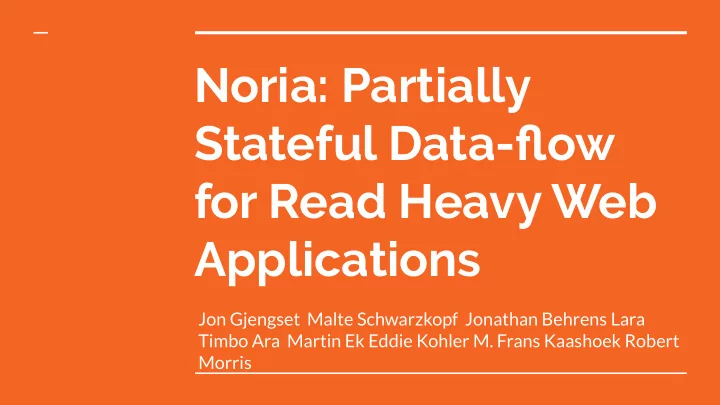

Noria: Partially Stateful Data-flow for Read Heavy Web Applications Jon Gjengset Malte Schwarzkopf Jonathan Behrens Lara Timbo Ara Martin Ek Eddie Kohler M. Frans Kaashoek Robert Morris
Challenges of Read Heavy Web Apps - Repeat reads for complex queries - De-normalise a relational database: complicates writes, hard to maintain - In-memory key-value cache (e.g. memcached), difficult to get efficient writes - Stream processing system (e.g. Twitter’s Heron) not general, hard to reconfigure
Noria’s Solution - Data-flow model with DAG composed of relational operators - Noria introduces three innovations: A ‘partially stateful’ dataflow model Automatic merge and reuse of data-flow subgraphs over multiple queries Fast, dynamic transitions for data-flow graphs in the presence of new queries and schema changes
Dataflow Design - Roots of the DAG are base tables - External views are at the leaves - Internal views are represented by relational operators - Updates are first applied to the base table and then propagate through the data-flow graph as deltas - Join operators use an upquery to process updates - better than just keeping windowed state - Some operators (e.g. projection, filter) are stateless, while some (e.g. count, min/max) are stateful to avoid redundant recomputation
Partial State: Challenges and Opportunities - Problem with stateful operators: leads to potentially unbounded state - Partial state, based around partially materialised views in databases allow operators to only contain a subset of their overall state - Introduces a new dataflow message: eviction notices
Partial State: Challenges and Opportunities - If an operator is missing state, it will issue a recursive upquery - Recursive upqueries introduce challenges around concurrency and correctness - Start with empty state, lazily issue upqueries - Only have partial state if can do index lookups
Dynamically Transitioning Dataflow - Common for web applications to change query set overtime - First stage of dataflow transition: plan what needs to be added to the dataflow graph, sharing and reusing operators wherever possible - Then add operators into the graph to support new queries: - Stateless - Partially stateful - Fully stateful
Implementation - 45k lines of Rust, RocksDB for persistent base tables - Sharding on hash partition on key, TCP interconnect - Two pools of worker threads: some to process updates, some to serve external views - MySQL adapter
Performance
Pros and Cons of the System - Seems very easy to integrate with existing web apps - Read performance very good for non-uniform - See biggest performance benefits with Zipfian distributions: how representative is this of other applications? - Recursive upqueries limit concurrency and complicate design
Questions
Recommend
More recommend